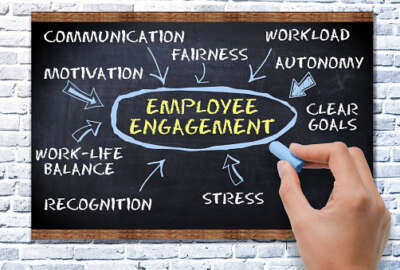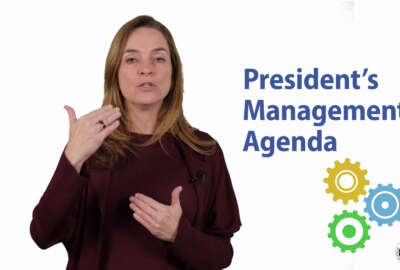
2018 Best Places to Work: Progress at largest federal agencies shines
Bright spots in the Partnership for Public Service's Best Places to Work in the Federal Government rankings show particular progress at some of the largest...
Best listening experience is on Chrome, Firefox or Safari. Subscribe to Federal Drive’s daily audio interviews on Apple Podcasts or PodcastOne.
It’s easy to look at the 2018 Best Places to Work in the Federal Government rankings from the Partnership for Public Service and find familiar stories or glaring red arrows that show engagement is trending down at some agencies.
A 7 percent drop for the Agriculture Department, a 31 percent collapse for the Federal Labor Relations Authority, and NASA is at number one, again.
But for Margaret Weichert, deputy director for management at the Office of Management and Budget and acting director of the Office of Personnel Management, the most exciting points in the Federal Employee Viewpoint Survey results and Partnership data come from the progress at particularly large organizations.
The Office of the Secretary of Defense, Joint Staff, defense agencies and DoD Field Activities — which are ranked together — are among the most improved large agencies in 2018. Collectively those organizations improved their score by 2.1 percent over the past year. In the area of strategic management, DoD’s fourth estate improved by nearly 4 points.
The Department of Veterans Affairs, which administered its own employee survey this year instead of OPM’s FEVS, saw a positive spike in engagement. VA is changing senior executives’ performance plans to include goals on sharing and using the results of the employee survey. The department has noticed a correlation between engagement scores at individual VA medical centers and hospital quality ratings, Nathan Maenle, the agency’s deputy chief human capital officer, told CHCOs earlier this month.
VA is the second-largest federal agency.
And the Department of Homeland Security, the third-largest agency with 240,000 employees, continued its rise this year.
“That right there is an absolute victory celebration,” Weichert said Wednesday morning at the Partnership’s Best Places to Work awards breakfast in Washington. “The people on the front lines of our law enforcement mission have had all kinds of challenges. Some of the challenges are management challenges: How quickly can we hire people to keep people with reasonable work-life balance? How do we take care of the people that we have? The increase from DHS is profound. It’s powerful, and it’s large.”
The Secret Service in particular, which has faced challenges with overtime, recruitment and retention, made considerable progress in 2018. The agency rose 11 points in the Best Places to Work rankings this year, earning the title of “most improved” agency subcomponent from the Partnership.
Agency uncertainty appears in Best Places to Work
Improving employee engagement has been a priority for the Trump administration in the President’s Management Agenda, and it’ll likely be an even bigger priority in 2019. Agency chief human capital officers have been using the data they receive from the FEVS and Best Places to Work rankings to tailor their engagement plans each year, but they’re beginning to expand and evolve how they reach out to their employees.
Weichert has said she sees an opportunity to enhance the types of programs agencies can offer to improve employees’ lives outside the office, which should translate into better engagement at work.
That starts, she said, with asking the right questions.
“What is most important? What affects the mission? What affects the most people? What affects whether they stay? What affects their outcomes?” Weichert said. “These are the things that I want us to draw [on].”
Despite the good news, other agencies — especially those that experienced high-profile leadership shakeups or drastic organizational changes — fell deep in the rankings this year.
“Sometimes in the short term during times of change, there’s a lot of uncertainty, [and] it might even show up in the numbers around Best Places to Work,” she said. “If you’re shaking up everything that everybody’s ever known, like USDA is, I would expect that we’d see some nervousness in our employees. Leadership is about saying, ‘We’ll get through this collectively and make the change that we want to have happen both for ourselves and for the American people.'”
At the Small Business Administration, which improved 2.6 percent in 2018 and earned the “most improved” midsize agency title this year, top leadership is, in fact, paying attention.
Related Stories

Engagement is up again in 2018 FEVS, but satisfaction with pay, performance are in the cellar
SBA ranks 20th among 27 midsize agencies, but it’s the second consecutive year in which the agency made large strides toward improvement. In 2017, SBA boosted employee satisfaction by more than 7 percent.
Hernandez said he, along with SBA’s chief financial officer, chief information officer and other top leaders, discuss and meet regularly to understand their specific strategies and priorities for their employees. That gives SBA a better sense of how IT or acquisition challenges might impact the organization more broadly, he said.
In addition, SBA Administrator Linda McMahon has consistently reminded the SES of the role they play in communicating with employees, Hernandez said.
“She has given us a challenge to the senior executives to continue to remind our employees that our organization is an organization where our employees can achieve the full capabilities of their professionalism,” he said.
Copyright © 2025 Federal News Network. All rights reserved. This website is not intended for users located within the European Economic Area.
Nicole Ogrysko is a reporter for Federal News Network focusing on the federal workforce and federal pay and benefits.
Follow @nogryskoWFED





